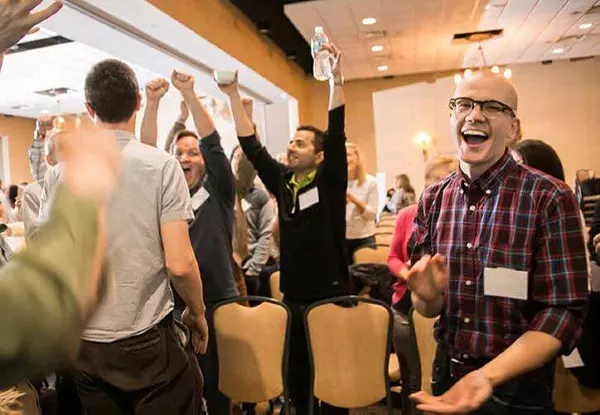This series of articles is focused on the topic of Strategy Activation. It is based on conversations that Aastha Minocha (Principal, Health Transformation) and John Schantz (Managing Director, Strategic Accounts) had with Dr. Wesley Burks (most recently CEO of UNC Health and Dean of UNC School of Medicine), supplemented with other experiences.
Part One: Leading Through Uncertainty | Authentic Presence
Part Two: A Roadmap for Creating Shared Meaning
If you’ve seen the YouTube video of the guy dancing uninhibited in a park, and one by one a massive group joins him, you know that “starting a movement” isn’t just about getting a crowd to follow you – it’s about cultivating a vision so compelling that others make it their own. Each individual joins the dancing group eventually, but the actual dance may look a little different for everyone. And most of the time, that’s okay.
Starting a movement isn’t as much about controlling the how as it is about clarity on the why and what. Movements are built when the mission remains constant, even if the methods look slightly different. They thrive when you invest in a few great leaders who influence many, you create a shared focus (the what), and then you step back so those leaders can authentically shape the journey. And at the heart of it all, movements are fueled by human connection – by bringing people together to believe in something bigger than themselves. Dr. Wesley Burks (most recently CEO of UNC Health and Dean of UNC School of Medicine) summarizes it in four steps: set a clear vision, find good leaders and invest in them, empower the group, and build a shared path forward. I had the privilege of talking with him recently about this concept and our experiences of great leaders doing it well over the years.
Anchor Everything to a Shared Why
The heart of a movement is its shared why. If that begins to drift, everything else unravels. But within that why, people will – and likely should – see things differently. They’ll come at it from different angles, bring different strengths, and contribute different perspectives. That’s not a threat to the why or ultimate goal; it’s a sign that it’s taking root.
What matters is that the why, or the shared vision of the future, is clear and consistent. It’s the anchor. As long as everyone is moving in the same direction, it’s not important that they take the same path to get there. In fact, a healthy movement thrives when its leaders and participants can bring their own experiences, creativity, and even tension to the work. Alignment doesn’t mean uniformity. It means a shared purpose and commitment. When people are trusted to live the why in their own authentic way, they own it more deeply. In Wesley’s words, “Ultimately you want every individual from the bedside to the front door to the person answering the phone to feel like they are a part of the vision, and it is meaningful and personal for them. No one is telling them ‘you ought to feel this way.’” Similarly, at Root, we say, “people will tolerate the directives of others, but ultimately they will act on their own conclusions,” which is at the core of our visual and dialogue-based methodology.
Focus on the Few to Influence the Many
When people talk about building movements, they often focus on reaching the masses. Although this is important, one leader cannot independently reach 10,000 or 20,000 or 50,000 people – even if you’re the CEO. Real impact comes from going deep with a smaller group. Wesley says, “overall, I only spend considerable time with 20 or so leaders regularly. It is those leaders that influence the thousands [of our teammates].” Selecting the right leaders and equipping them with the appropriate tools and resources allows them to influence and lead hundreds, maybe thousands.
These are the people who carry and craft the movement. If you pour into them through mentorship, accountability, encouragement, and trust, they multiply the message and model the desired culture. And they’ll do it far better than any one person alone. Leadership in a movement isn’t about charisma or control. It’s about raising up others who can lead in ways you can’t to scale the vision.
Don’t Make All the Decisions – Design an Environment of Action
As Wesley says, “You shouldn’t be making many decisions at all. If you set the vision, find the right people, and invest in them, they will come up with the right answer and that will keep them engaged in the journey.” If you’ve clearly communicated the why, selected the right leaders, and equipped them well, step back. Your job isn’t to make every call. In fact, the more decisions you make, the more you rob others of ownership. If the people closest to the ground aren’t making key decisions, they’ll eventually check out or burn out.
Successful movements are ultimately sustained not by control, but by trust. When people feel agency, they stay engaged. When they shape the how using their own expertise and experience, they stay invested. Your job becomes less about answers and more about questions. Less about control and more about inspiration. Let the leaders you’ve empowered solve most of the challenges.
Connect Your People
No matter how vast and distributed a movement becomes, it has to stay unified. People need to feel like they’re part of a team and dance in the same direction instead of running into one another. They need to hear the stories, see the impact, and know they’re not alone in both the hard times and the good.
That’s why it’s essential to create regular time and spaces to gather, whether in person or virtually. These aren’t just meetings. They’re energizing moments to re-center on the why, celebrate progress, wrestle authentically with setbacks, and remind each other why this work matters. Shared experiences build shared identity. They create belonging, alignment, and energy. Don’t underestimate the power of bringing people together – movements lose momentum when people lose connection.
In a time when healthcare organizations are collectively facing funding shortages and thinking of ways to cut costs, spending thousands of dollars to bring people together may seem counterintuitive. No more social gatherings. No pizza or coffee in department meetings. No team offsites. Saving a penny on a bite while losing a dollar on passion. During these times, it’s more important than ever to keep people energized and remind them why they joined healthcare and your organization in the first place.
——–
If you want to start a movement, don’t try to lead everyone at once. Lead a few really well. Make the why and what – the vision – unmistakably clear. Then let people interpret the how through their own lens a little. Step back and trust them to lead.
The most meaningful movements aren’t powered by the person at the top. They’re powered by people at every level who believe in something bigger than themselves – something they’re a part of – and have been trusted to carry it forward. That trust creates energy, and that energy builds momentum. And that momentum is what turns an idea into a movement.
Part Four: Driving New Behaviors: The Key to Operating as One








